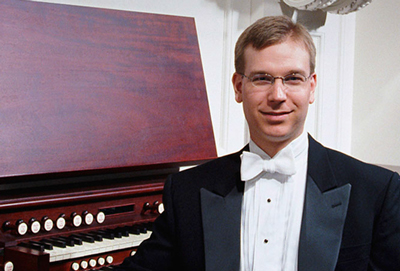by Timothy Robson

Concert organist, former organist at Washington’s National Cathedral, and Oberlin alumnus Erik Wm. Suter played all of Duruflé’s original solo works on Tuesday, February 9 at Oberlin’s Finney Chapel on the school’s French Romantic-inspired Fisk organ. Suter played to a slim crowd, due to snowy weather and treacherous roads, but the hardy souls who made it were treated to fine playing.
Maurice Duruflé was inspired by the French Impressionist composers, but equally by Gregorian chant, which was having a resurgence in the 1920s and ‘30s when Duruflé was a student under the influence of organist-composer Charles Tournemire. That composer’s vast compositional output for organ stands in stark contrast to Duruflé’s mere handful of pieces, yet each of Duruflé’s works is a gem, painstakingly crafted and revised with great care, sometimes years later. The concert, lasting less than 90 minutes, was played without intermission, a daunting task for which Erik Wm. Suter was well-prepared.
Suter did not perform the works chronologically but in a pleasing recital order. He opened with Fugue sur le Thème du Carillon des Heures de la Cathédral de Soissons, Op. 12, from 1962. The theme consists of eight descending notes set in a minor key. The piece follows the rules of fugue, including a majestic stretto at the end, in which the theme is “piled up” in several voices and appears simultaneously in long notes in the pedal, leading to a blazing conclusion. Suter’s reading was urgent, always pressing on, but not quite stepping over the line of being rushed.
The Méditation pour Orgue, Op. Posthumous, was not published until 2002. Sketched in 1964, the main thematic material was appropriated for the “Agnus Dei” of his Messe “Cum jubilo” of 1966. Duruflé was a master of organ registration, and here the organ’s richly voiced “cornet” is pitted against the soft, mellow “voix celeste.” The Méditation is one of the few works of Duruflé’s that an organist of less-than-virtuoso stature might attempt. Suter’s performance was serene, an oasis of calm before the major virtuoso works yet to come on the program.
The Prélude et Fugue sur le nom d’Alain, Op. 7, was composed as a tribute to Duruflé’s friend Jehan Alain, a brilliant composer who was killed in World War II. Duruflé spelled Alain’s name in musical notes, and the resulting theme forms the basis for a prelude and brilliant fugue that also incorporates the theme from Alain’s own Litanies. The prelude is a kind of scherzo; the fugue, in Suter’s commanding performance, built to a thrilling climax.
Duruflé’s Prélude, Adagio, et Choral Varié sur le thème du Veni Creator, Op. 4, is his homage to Charles Tournemire using the plainsong hymn for Pentecost. Arabesques of great fantasy on the flute stops form the prelude, and a lush Adagio never completely states the chant. Finally, a series of masterfully inventive contrapuntal variations fully reveal the plainsong, ending in a full-organ toccata. In its cohesion and technical achievement, this was Suter’s best playing of the evening.
Prélude sur l’Introit de l’Épihanie, Op. 13, followed. Designed for liturgical purposes, which it undoubtedly served well, the brief piece is a minor work.
Duruflé’s first published composition, the Scherzo, Op. 2, was also dedicated to Tournemire. Light, joyful, and influenced by Ravel, it sounds deceptively simple. Suter had its tricks well in hand.
The Suite pour Orgue, Op. 5, closed the program. Its ominous, cortège-like “Prélude” builds to a huge climax before dying out to an inconclusive-sounding end. The middle movement, “Sicilienne,” begins gently, resembling a French folk song, then continues to a series of increasingly complex variations, each more virtuosic than the last. A huge, dissonant “Toccata” closes the suite and ended the concert. Until recent years, performances of the Toccata were limited due to its great technical difficulty, but is now quite common on programs, perhaps too much so. Nonetheless, Erik Wm. Suter has the chops to do it justice, and it was a fine ending to an excellent performance.
Published on ClevelandClassical.com February 14, 2016.
Click here for a printable copy of this article

